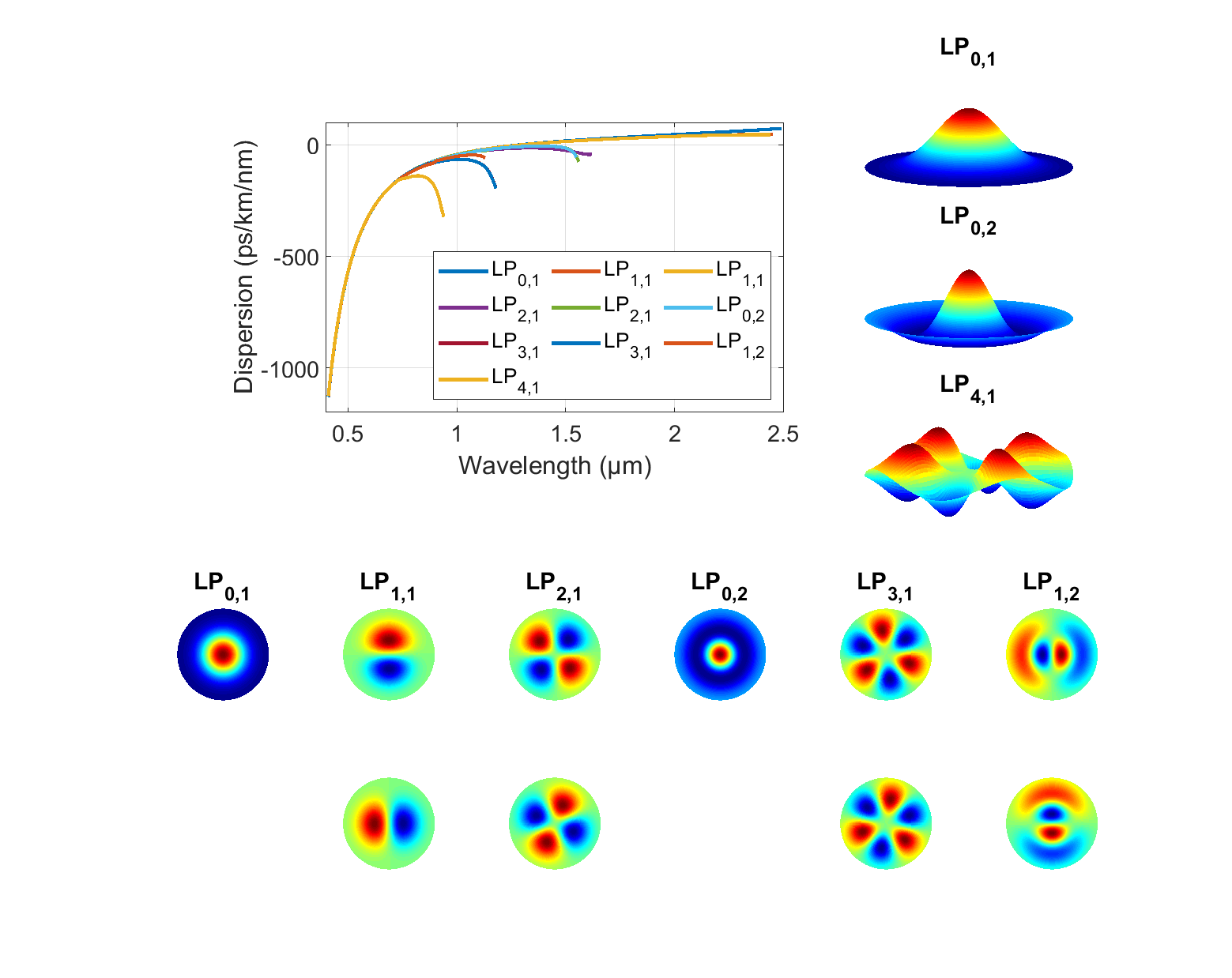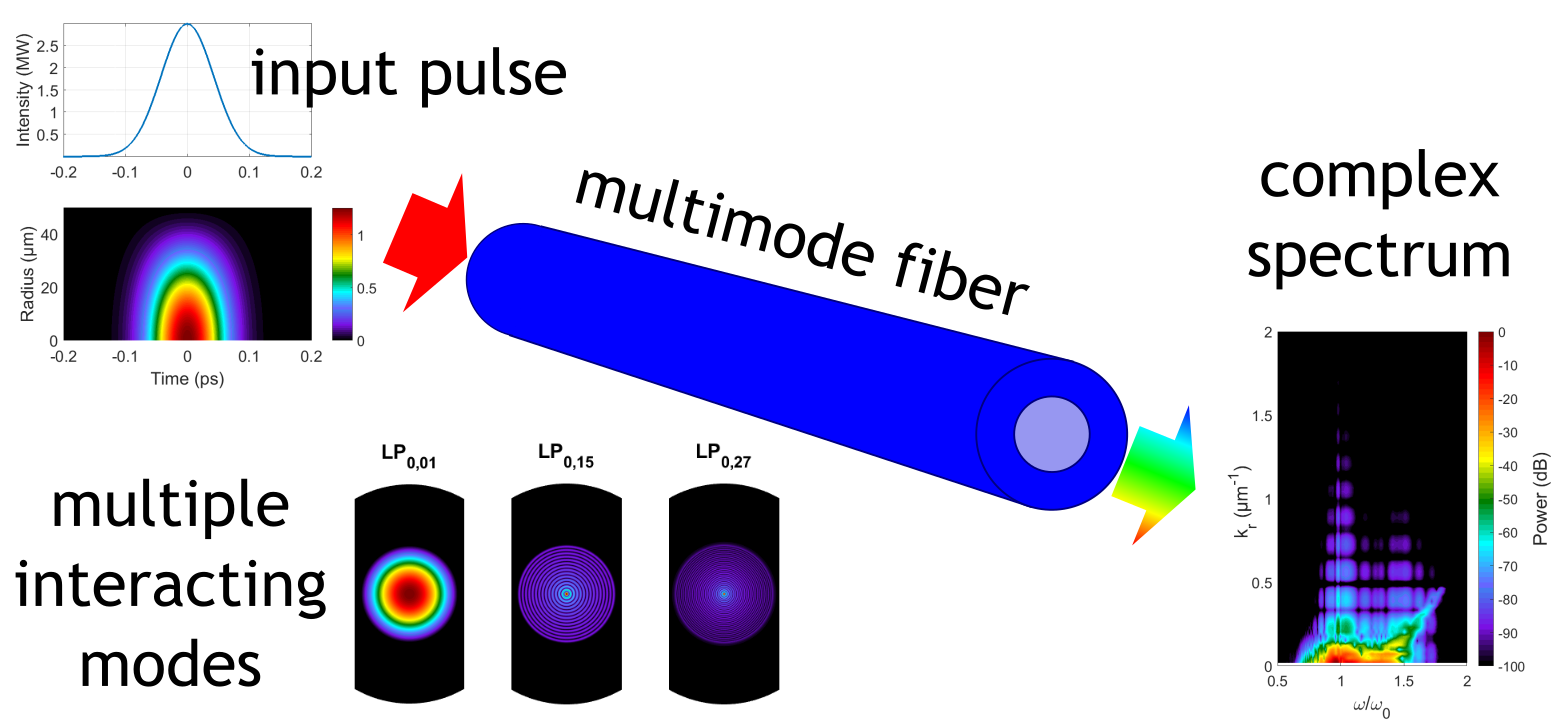Discretized conical emission in multimode optical fibers

Nonlinear optics is a branch of optics dealing with phenomena that are a consequence of light-induced modifications to the optical properties of matter. Optical fibers are a very attractive medium for studying nonlinear phenomena. Due to the small size of the core and the geometry of the fibers, which allows light to propagate over very long distances, the waveguides can show non-linearity even for relatively low power of the initial pulses.
The significant part of the research on nonlinear phenomena in optical fibers concerns single-mode optical fibers. Due to their design, they allow only one mode to propagate for a given light frequency. In practice, they are used in fiber-optic networks to transmit information. Recently, the interest in multimode fibers brought interesting results concerning spatiotemporal nonlinear effects and intermodal frequency conversion [1-3]. This interest is related to the potential use of multimode optical fibers in telecommunications networks. In this type of fibers, for a given frequency, there are many spatial distributions of the guided light. Sending information in different modes allows for a further multiplication of throughput, although it requires the development of methods of sending, redirecting and receiving information in many modes simultaneously [4].
Multimode optical fiber
Multimode optical fibers can support multiple guided modes for a given wavelength. Their number is determined by the optical frequency and the refractive index profile of investigated fiber. Each guided mode propagates in a specific manner, which could be shown as its electromagnetic field distribution. Identification of linearly polarized (LP) modes is based on determining the number of extremes along two field cross-sections: radial and transversal. The field distribution of the same mode could be slightly different depending on wavelength and reflective index profile.

Example normalized component of electromagnetic field of mode solutions in multimode fiber.
At the same time, we can think of a multimode fiber as a transition material between a bulk material and a single-mode fiber. This makes them ideal for exploring the connection between nonlinear phenomena occurring in these two material mediums. One of such nonlinear phenomena is a conical emission observed in bulk as a colored ring surrounding the central spot of light [5,6]. Moreover, in our recent works, we generalized the concept of conical waves described in bulk media towards structured media, such as multimode optical fibers, in which only a discrete and finite number of modes can propagate [7, 8].
Numerical modelling
We compare the two numerical approaches for modelling nonlinear propagation in mutlimode optical fibers: generalized multimode nonlinear Schrödinger equations (MM-GNLSE) [9], which considers a modal decomposition of the electrical field and then intermodal nonlinear couplings, and unidirectional pulse propagation equation (UPPE) [10,11], which have been widely used for studying nonlinear optics in bulk transparent media and gases.
In both approaches we can distinguish between dispersive and nonlinear terms. In general, as a hard and fast rule, the dispersive part dictates the light velocity in the medium and some electromagnetic losses while the nonlinear part is related to nonlinear effects observed in optical fibers (which in particular can be observed in the form of some frequency shifts). Dispersion and nonlinearity are often separated and described independently using the split-step Fourier transform method (SSFM) which takes the least computation time among all compared numerical schemes for these types of problems.
The numerical tools offer an excellent opportunity for deep inspection of light propagation in the computational investigation of nonlinear phenomena occurring in multimode fibers. Moreover, the achieved results of numerical simulations support the experimental works and allow to indicate alluring phenomena. With numerical modelling, one has access to all information about light on the whole propagation distance (not only measured on output). Additionally, it is possible to switch on and off different terms of the solved equation (in fact excluding specific phenomena) to understand the underlying physics.
However, most of the time, the derived numerical models only support qualitatively experimental results, in particular, when the number of modes involved becomes significant (i.e., higher than 10) and ultra-broadband frequency conversion processes (i.e., more than one octave) also occurs. There is an urgent need of clarifying the potential and areas of applicability of numerical models to facilitate the accurate design of future nonlinear and multimode fiber devices.
Discretized conical emission
In our studies, we investigated ultrashort pulse propagation (for femtoseconds duration of input laser pulse) in multimode fibers with a peak power around the critical power, which is defined as the highest possible power, which can be applied to material without destroying it. We observed formation of, as we called it discretized conical waves, to be precise discretized X waves.

Schematic representation of considered setup.
Conical emission has been intensively studied in dispersive nonlinear bulk media, in particular in the filamentation regime. The interpretation of light filaments in the normal dispersion (where group velocity decreases with increasing optical frequency) usually present typical features such as pulse splitting and conical emission, and it can be interpreted assuming the pulses as spontaneously emerging nonlinear X-waves. More specifically, off-axis (conical) tails emerge on both the blue and red-shifted sides of the input wavelength, forming a universal distinct X-shaped pattern of conical emission. It was found that the input pulse can evolve toward a final stationary state that has the form of either an X-wave in the range of normal dispersion or an O-wave in the range of anomalous dispersion. Nonlinear X-waves and O-waves are named because of their evident X-like and O-like shapes, respectively, which appear in both the near and the far fields.
The sign of dispersion governs the dynamics of femtosecond filaments and so the time-frequency content of the associated supercontinuum. It was demonstrated that the dispersion landscape is the key ingredient for accurately modeling conical emission as it governs the specific shape of the conical emission patterns (X-shaped for normal dispersion, O-shaped for anomalous dispersion, or fish-shaped as their combination when pumping close to the zero dispersion). In the case of multimode fibers, only a discrete number of guided modes is available and discrete conical emission is expected. The spectral position of the conical wave component in each mode can be predicted by using experimentally derived phase-matching condition [7].The sign of dispersion governs the dynamics of femtosecond filaments and so the time-frequency content of the associated supercontinuum (generated white light composed of very wide frequency range). It was demonstrated that the dispersion landscape is the key ingredient for accurately modeling conical emission as it governs the specific shape of the conical emission patterns: X-shaped for normal dispersion, O-shaped for anomalous dispersion, or fish-shaped as their combination when pumping close to the zero dispersion. In the case of multimode fibers, only a discrete number of guided modes is available and discrete conical emission is expected. The spectral position of the conical wave component in each mode can be predicted by using experimentally derived phase-matching condition [7].

Mode number-resolved X-wave conical emission spectra after 2cm propagation for both modeling methods. The white squares indicate central phase-matched frequencies in each spatial mode. In the case of MM-GNLSE we investigated only 15 modes, which can propagate in the investigated fiber.
When comparing results achieved using both models, we see a qualitative agreement about the strong spectral broadening associated with self-focusing, as well as energy spreading in higher-order modes from the fundamental mode LP01. We also denoted the typical signature of X-pattern formation. However, it clearly appears that MM-GNLSE overestimates the overall nonlinear response compared to the UPPE approach, thus leading to a larger spectrum, a higher peak power in the space–time domain, and larger power spectral densities in higher-order modes.
Conclusions
In our experiments we numerically studied the highly nonlinear regime of ultrashort pulse propagation in multimode step-index silica fibers by comparing two well-known modeling approaches.
Our main results show the strong impact of the frequency dispersion of the nonlinear response on pulse splitting and supercontinuum dynamics in the femtosecond regime. This easily-accessible pumping regime, from the experimental point of view, appears as a good starting point to reveal some limitations of approximated numerical models such as the MM-GNLSE. Moreover, we show that the resulting spatiotemporal dynamics are associated with conical wave formation.
Literature
[1] W. H. Renninger and F. W. Wise. Optical solitons in graded-index multimode fibres. Nature Communications, 4:1716–1719, 2013.
[2] L. G. Wright, D. N. Christodoulides, and Frank W. Wise. Controllable spatiotemporal nonlinear effects in multimode fibres. Nature Photonics, 9:306–310, 2015.
[3] K. Krupa, A. Tonello, A. Barthelemy, T. Mansuryan, V. Couderc, G. Millot, P. Grelu, D. Modotto, S. A. Babin, and S. Wabnitz. Multimode nonlinear fiber optics, a spatiotemporal avenue. APL Photonics, 4(11):110901, 2019.
[4] D.J. Richardson, John Fini, and Lynn Nelson. Space division multiplexing in optical fibres. Nature Photonics, 7:354–362, 05 2013.
[5] R.R. Alfano and S.L Shapiro. Emission in the region 4000 To 7000A via four-photon coupling in glass. Physical Review Letters, 24:584–588, 1970.
[6] D. Faccio, A. Couairon, and P. Di Trapani. Conical Waves, Filaments and Nonlinear Filamentation Optics. Aracne, Rome, 2007.
[7] B. Kibler and P. Bejot. Discretized Conical Waves in Multimode Optical Fibers. Physical Review Letters,126(2):023902, 2021.
[8] K. Tarnowski, S. Majchrowska, P. Bejot, and B. Kibler. Numerical modelings of ultrashort pulse propagation and conical emission in multimode optical fibers. Journal of the Optical Society of America B, 38(3):732,2021.
[9] F. Poletti and P. Horak. Description of ultrashort pulse propagation in multimode optical fibers. Journal of the Optical Society of America B, 25:1645–1653, 2008.
[10] M. Kolesik, J V Moloney, and M Mlejnek. Unidirectional Optical Pulse Propagation Equation. Physical Review Letters,89(28):283902, 2002.
[11] J. Andreasen and M. Kolesik. Nonlinear propagation of light in structured media: Generalized unidirectional pulse propagation equations. Physical Review E - Statistical, Nonlinear, and Soft Matter Physics, 86(3):1–9, 2012.